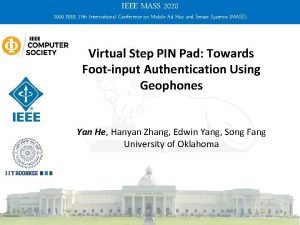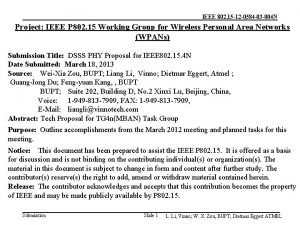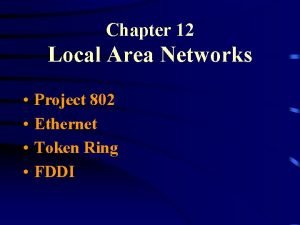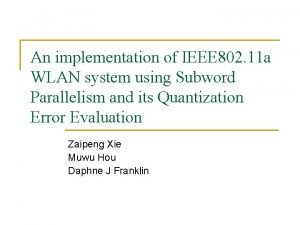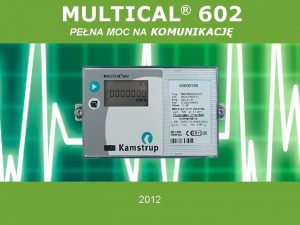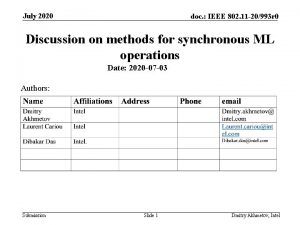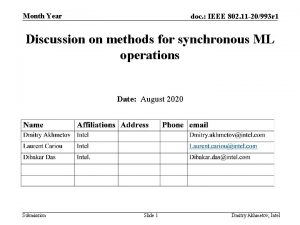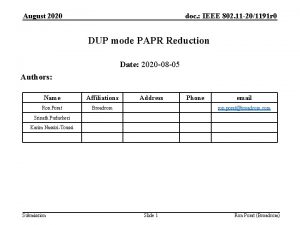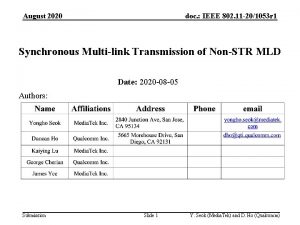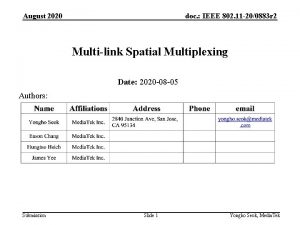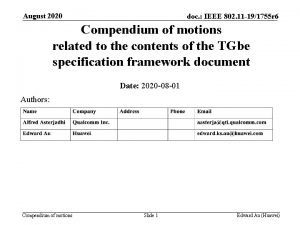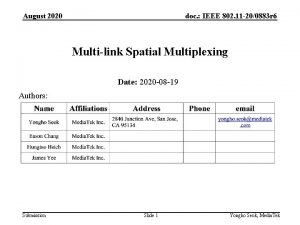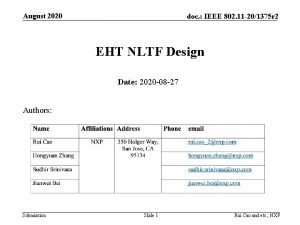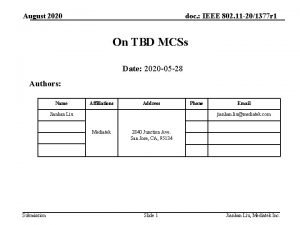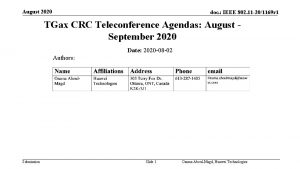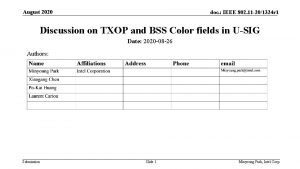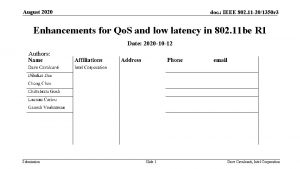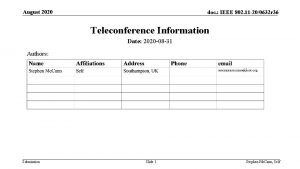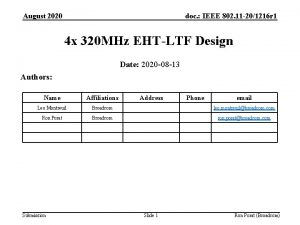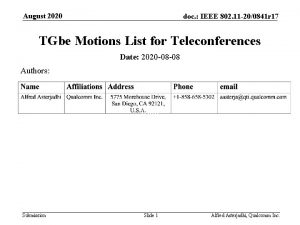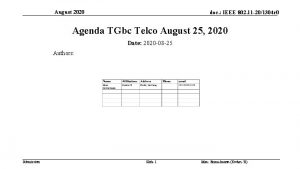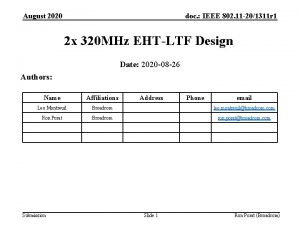August 2020 doc IEEE 802 11 20993 r




















- Slides: 20

August 2020 doc. : IEEE 802. 11 -20/993 r 4 Discussion on methods for synchronous ML operations Date: August 2020 Submission Slide 1 Dmitry Akhmetov, Intel

August 2020 doc. : IEEE 802. 11 -20/993 r 4 Introduction • non-STR device • Leakage from TX on link 1 cause STA of the same MLD to detect medium as BUSY on link 2 • Under such considerations • Concurrent UL/Link aggregation in UL is difficult • Non-AP MLD still benefit from latency gain • DL aggregation may require special treatment for optimal performance Submission Slide 2 Dmitry Akhmetov, Intel

August 2020 doc. : IEEE 802. 11 -20/993 r 4 Considerations for UL aggregation • • • Why do we need it? • To fix/improve UL performance by enabling UL aggregation at non-STR device • Although it is mainly needed for massive/saturated UL case, i. e. limited application Sync access typically is not frequent • Numerous contributions show that sync access (i. e. medium available on more than one link at a time) is a function of network load. • Chances for sync access are small in a busy network • Sync access would only work and provide throughput increase in a non-congested environment If we to design a mode for UL link aggregation at non-STR devices, it: • need to work for both congested and non-congested environments and be network independent • need to follow existing regulations • need to be fair to legacy devices as well as STR MLD STAs. • not to violate/break existing EDCA mechanism • naturally extend existing EDCA mechanism w/o adding new mode of operation Submission Slide 3 Dmitry Akhmetov, Intel

August 2020 doc. : IEEE 802. 11 -20/993 r 4 Overview of proposals/ideas • There are multiple proposals for link aggregation for both STR and non-STR devices • Primary/Secondary concept. Contention on “primary/anchor” link + PIFS ED check on secondary • Independent contention on both links + PIFS ED check. The winning link “invite” the other link into sync transmission if the other link is IDLE for PIFS • Independent contention on both links • + PIFS ED check + NAV check • + PIFS ED + NAV + “add truncated slots back” • + Medium IDLE with slots truncation + “add truncated slots back” + “link alternation” • AP assisted UL aggregation. STA send a frame to solicit TF on two links. PIFS ED check used on AP side might be used • AP initiated UL aggregation with PPDU end alignment to later send TF for UL • PIFS seems to be in favor as a very simple option to use • despite associated problems Submission Slide 4 Dmitry Akhmetov, Intel

August 2020 doc. : IEEE 802. 11 -20/993 r 4 Problem(s) statement(s) • • • Independent EDCA operation on each link • To get most of ML benefits we need treat each link as an independent link • Each link have its own load and its own interference picture • Each STA of a non-STR MLD is in sync with other STAs operating on that links (i. e. CCA, NAV, etc). To not PIFS or not to PIFS – that is a regulatory question. Coexistence/fairness with legacy/STR MLD devices require special attention • It is clear that PIFS access brings unfairness to other devices • New rules need to be introduced to address fairness in most cases A STA of non-STR MLD does not hear a STA! • deafness caused by TX on another link may require some special handling • No blindness recovery mechanisms currently agreed/defined PIFS-initiated TX disrupt EDCA “synchronization” of an invited link • Each successful TX on a link reset CW. PIFS access would unfairly shorten existing recovery process on a link • PIFS approach unfairly shorten channel access time regardless of network state on that link • In case of unequal link load, more loaded/congested link may end up transmitting mostly because of invitations from less loaded link and not because own EDCA process Submission Slide 5 Dmitry Akhmetov, Intel

August 2020 doc. : IEEE 802. 11 -20/993 r 4 Proposal 0 (PIFS) • PIFS based approach: • • Perform contention on both links. The winning link can trigger transmission on another link if medium of another link is IDLE for PIFS (ED check) • Does not solve the unfairness issue since STA still gets more channel access than using regular EDCA. • Advance ahead entire backoff sequence • Does not take into account interference/congestion/NAV of invited links • In presence of many non-STR devices can easily lead to double collision STA SIFS Back-off BUSY 6 GHz 765 A IF S N 43 2 1 0 RTS STA 9 876 5 Transmit if PIFS IDLE Submission A-MPDU Invite SIFS BUSY 5 GHz CTS A I F S N RTS Slide 6 CTS A-MPDU Dmitry Akhmetov, Intel

August 2020 doc. : IEEE 802. 11 -20/993 r 4 Proposal 1 (e. PIFS) • Enhanced PIFS: • Perform contention on both links. The winning link can trigger transmission on another link if • • Credit based system to promote fairness – at next backoff add slots to the invited link • Fairer as it add “truncated slots” back to the counter of invited link • • medium of another link is IDLE for PIFS (ED check) and NAV not set This only “advance” one current contention but not the following ones. Issues: • NAV check might be a problem • • Non-STR STA naturally suffer from deafness and may not have up-to-date NAV information Still does not address unequal load problem • Lightly loaded link 1 can have multiple opportunities to invite link 2 using PIFS access giving unfair advantage over other devices operating on link 2 • Link which is add slots back to counter may be over excessively punished in case of consecutive invites. Link “alternation” or some other mechanism may be required to avoid this problem 6 GHz TX BUSY STA 765 SIFS Back-off 4 3210 CTS A-MPDU RTS Invite BUSY 5 GHz STA 9 876 5 432 SIFS RTS CTS A-MPDU Transmit if PIFS IDLE and NAV not set Submission Slide 7 Dmitry Akhmetov, Intel

August 2020 doc. : IEEE 802. 11 -20/993 r 4 Proposal 2 (Wait Slot) • Each STA of an MLD follows regular EDCA mechanism on each link independently. • A STA can perform synchronous PPDU transmission if BO on both links reaches zero • • • the STA on link 1 may hold the BO counter at zero value until BO of link 2 reaches zero • while waiting for link 2, STA on link 1 continue monitoring medium state of link 1 • after EDCA count down procedure is completed on both links and medium on both links is IDLE MDL can transmit synchronously on that links Certainly fair to legacy STAs and EHT STAs on both link. • Does not promote channel access of any STA of the MLD of any link • Keep NAV/CCA/contention synchronization with other devices on any link intact Flexible • STA on link 1 may choose to wait for link 2 if BO of a STA on link 2 is near completion and/or channel on link 1 is not expected to change. • STA may decide to proceed with transmission w/o waiting the other link • does not get penalized in advance for choosing larger BO window (i. e. do not chose BO for both links at the same time) Back-off BUSY 6 GHz STA 765 4 3 2 1 00 0 BUSY 5 GHz STA Submission 9 876 5 4 SIFS RTS Back-off 3 21 0 CTS A-MPDU SIFS RTS Slide 8 CTS A-MPDU Dmitry Akhmetov, Intel

August 2020 doc. : IEEE 802. 11 -20/993 r 4 Proposal 2 (Wait Slot) cont. • There may be issue if medium on one of the link became busy • • • Multiple STAs in a BSS may hold their BO count at the zero value At next contention they may transmit simultaneously resulting in collisions. Following option address this problem • Case 1: When link 1 becomes busy, and link 1 is waiting at BO equal to zero, link 1 shall not transmit and shall draw a new random number without modifying the CW (internal collision) • Case 2: When link 2 becomes busy, and link 1 is waiting at BO equal to zero, link 1 shall not transmit and shall draw a new random number without modifying the CW (internal collision) Case 1 6 GHz/Link 1 BUSY STA 654 Submission 32 100 Internal collision 5 GHz/Link 2 STA Back-off BUSY 9 876 5 Back-off 43 21 0 Case 2 Internal collision BUSY New BO TXOP 6 5 4 3 2 10 7 6 5 43 21 0 New BO BUSY TXOP 9 8 7 6 5 43 Slide 9 Dmitry Akhmetov, Intel

August 2020 doc. : IEEE 802. 11 -20/993 r 4 Simulation results unequal link load • • 1 AP, 1 STA, 1 x 1 x 80, MCS 11 Full buffer in UL direction RTS ON, AMPDU = 256 frames Added interference: • Link 1 has 1 OBSS • Link 2 has 1 -8 OBSSes • OBSS consist of 1 AP/1 STA with 6 Mbps load in both directions • • Submission 15 Kb chunk of data arrive every 20 ms (fragmented in 1. 5 k frames) OBSS STA/AP deliver data using MCS 0 Random OBSS TXOP size between 0. 5 ms and 5 ms for every transmission A single 15 Kb chunk require ~3. 7 -4 ms for complete delivery Slide 10 Dmitry Akhmetov, Intel

August 2020 doc. : IEEE 802. 11 -20/993 r 4 TXOP initiation on a link • STA of a non-STR device has limited ability to initiate TXOP of link • upon completion of contention on link 1 it check status of link 2 • link 2 might be performing some actions that can be affected by leakage such as receive or expect to receive response frame • Link 1 allowed to initiate TXOP if status of link 2 is • • SLOT (i. e. in backoff) PIFS IDLE PIFS + NAV not set RX • If STA on link 2 is not an intended receiver of ongoing reception • Otherwise Link 1 cannot initiate TXOP Submission Slide 11 Dmitry Akhmetov, Intel

August 2020 doc. : IEEE 802. 11 -20/993 r 4 Throughput comparison SYNC modes # BSS on a Load, airtime Async, Mbps link 2 0% 0 553. 9 20 1 477. 5 40 2 354. 7 60 3 337. 0 80 4 336. 4 100 5 333. 2 120 6 331. 4 140 7 322. 6 160 8 331. 6 • Delta vs ASYNC , async=100% e. PIFS, Mbps Wait, Mbps vs e. PIFS vs PIFS 1087. 6 600. 0 371. 3 363. 1 361. 8 356. 1 353. 8 355. 7 341. 6 1094. 9 609. 4 399. 1 389. 9 380. 9 376. 5 372. 6 369. 0 374. 5 1091. 2 578. 6 369. 9 350. 3 352. 5 349. 9 346. 1 342. 5 340. 5 96. 3 25. 7 4. 7 7. 5 6. 9 6. 8 10. 3 3. 0 97. 7 27. 6 12. 5 15. 7 13. 2 13. 0 12. 4 14. 4 12. 9 % vs Wait vs e. PIFS 97. 0 21. 2 4. 3 3. 9 4. 8 5. 0 4. 4 6. 2 2. 7 -0. 3 3. 7 0. 4 3. 7 2. 6 1. 8 2. 2 3. 9 0. 3 For low load case performance of SYNC modes is • • nearly identical And significantly higher than Async mode of operation • When network became congested all schemes converge to single link like performance of with Async channel access • Expect to see non-STR STA throughput performance numbers close to Async access in majority of use cases Submission Slide 12 Dmitry Akhmetov, Intel

August 2020 doc. : IEEE 802. 11 -20/993 r 4 Attempts for synchronization Load, airtime = 0% Sync Async 784 2 1084 3 954 2 923 4 976 2 883 3 Link 1 Link 2 e. PIFS WAIT Load, airtime = 20% Sync Async 301 463 331 464 297 509 308 487 244 587 247 558 Load, airtime = 100% Sync Async 11 35 79 1072 44 191 88 1006 18 138 20 1098 Async mean # of unsuccessful invitations for concurrent transmission, recorded at "invited" side Sync mean # of successful invitations for concurrent transmission, recorded at "invited" side % of sync transmission load, airtime 0 20 40 60 80 100 120 140 160 Submission e. PIFS WAIT 99. 7 39. 2 11. 9 10. 3 10. 1 9. 2 10. 3 8. 9 99. 7 37. 8 13. 6 12. 7 11. 8 10. 9 9. 7 11. 0 99. 7 27. 3 5. 3 3. 7 3. 8 3. 1 3. 6 2. 9 • With minor load there is a good chance of concurrent synchronous transmissions on two links • As network load increase chances dropping to ~10% for PIFS based access and ~3 -5% for WAIT access Slide 13 Dmitry Akhmetov, Intel

August 2020 doc. : IEEE 802. 11 -20/993 r 4 Fairness issues of medium access on Link 2 *SYNC initiated transmission – transmission that started because of “invitation from the other link” **STA/SELF initiated transmission - transmission that started because of winning contention on the link • In non-congested case WAIT and PIFS modes have similar number of SYNC-initiated TXOPs • In congested cases about 50% of transmissions on link 2 are SYNC-initiated in PIFS case • • Link 1 (less congested) simply trigger/initiate TXOP on link 2 (more congested) • Half of initiated TXOP happens regardless of EDCA state on link 2 PIFS-based access create disbalance in access between links Submission Slide 14 Dmitry Akhmetov, Intel

August 2020 doc. : IEEE 802. 11 -20/993 r 4 Summary • • • In a non congested environment all solutions work equally well PIFS access looks attractive but comes with inherent defects. • • Most of PIFS-based variants does not provide fairness • • PIFS based methods disrupt regular EDCA operations on a link Some variations of PIFS-based access can improve fairness to other devices but does not address unequal load/congestion problem More importantly, subject to regulatory constraints With minimal changes we can introduce a mechanism which utilize existing standard EDCA process for sync cannel access • Does not require regulatory changes • Keep EDCA operation of legacy and STR MLD devices intact • Keep fairness to other devices • Address (i. e. does not require anything) issue of unequal link load • Enable alignment of UL transmissions in a fair way. Submission Slide 15 Dmitry Akhmetov, Intel

August 2020 doc. : IEEE 802. 11 -20/993 r 4 SP • A STA MLD that intends to align the start time of the PPDUs sent on more than one link shall ensure that EDCA count down procedure is completed on all the links • Note: STA MLD is the sole originator of an intended sync transmission Submission Slide 16 Dmitry Akhmetov, Intel

August 2020 doc. : IEEE 802. 11 -20/993 r 4 Backup Submission Slide 17 Dmitry Akhmetov, Intel

August 2020 doc. : IEEE 802. 11 -20/993 r 4 Illustration of unfairness of PIFS Submission Slide 18 Dmitry Akhmetov, Intel

August 2020 Submission doc. : IEEE 802. 11 -20/993 r 4 Slide 19 Dmitry Akhmetov, Intel

August 2020 Submission doc. : IEEE 802. 11 -20/993 r 4 Slide 20 Dmitry Akhmetov, Intel
 Bridges from 802.x to 802.y
Bridges from 802.x to 802.y Bridges from 802.x to 802.y
Bridges from 802.x to 802.y 802 ieee
802 ieee 802 ieee
802 ieee Ieee 802 family
Ieee 802 family Ieee 802
Ieee 802 Ieee 802 standard
Ieee 802 standard Ieee 802
Ieee 802 Ieee 802 3 compliance
Ieee 802 3 compliance Arquitetura ieee 802
Arquitetura ieee 802 Ieee 802 bluetooth
Ieee 802 bluetooth Ieee mass 2020
Ieee mass 2020 Format rps dikti 2020 doc
Format rps dikti 2020 doc Matrik rpjm desa 2020 doc
Matrik rpjm desa 2020 doc Oświadczenie o wypadku w pracy
Oświadczenie o wypadku w pracy Mac address
Mac address 802 15
802 15 What is project 802
What is project 802 Wlan 802
Wlan 802 Geo 802
Geo 802 Filler 602
Filler 602











